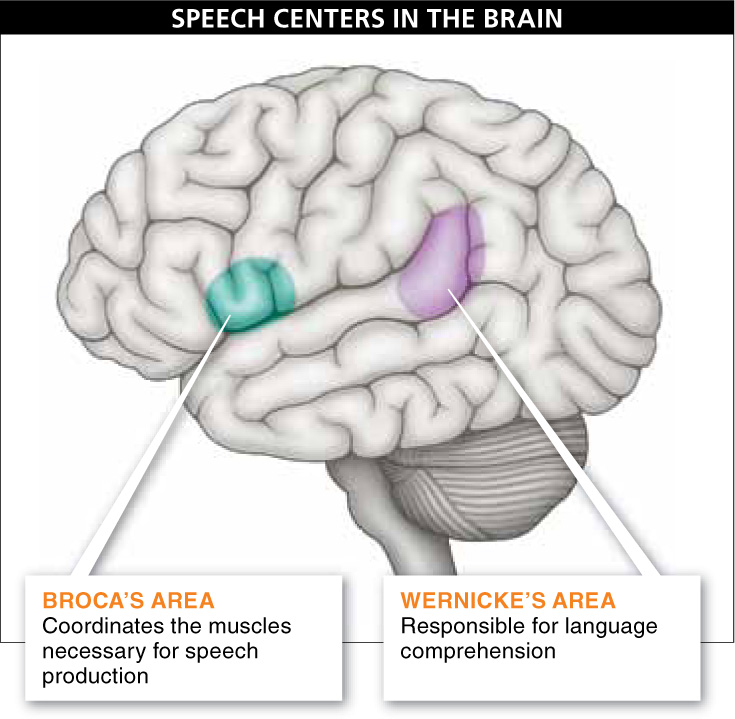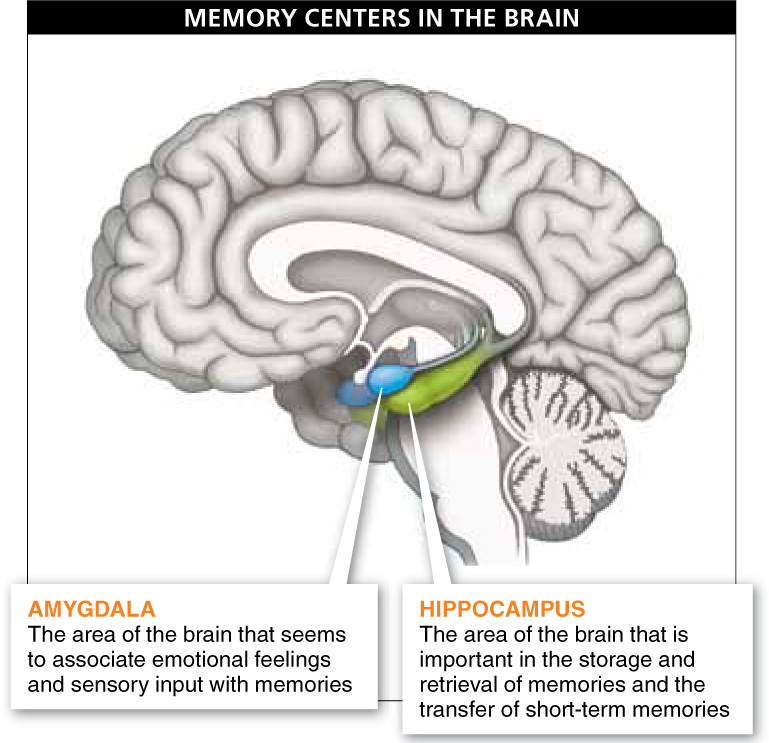Brains are capable of myriad amazing feats. Learning and memory, along with the use of complex language, are among the most sophisticated and enigmatic of these functions. These abilities rank among the greatest mysteries of the brain, but we’re unlocking its secrets every day.
Language What is language exactly? In its most broad interpretation, language is simply the means of communication between individuals of any species. In humans, language has evolved to its most complex level. Words and sentences allow us to convey not just simple information but also complex thoughts such as things and events distant in space or time, something rarely if ever seen in other species.

Several distinct brain structures, and two in particular, are necessary for the acquisition and use of language. One is required for the understanding of speech, including the linking of words with meaning (FIGURE 23-44). Located in the left temporal lobe, this region is called Wernicke’s area. People with damage to Wernicke’s area (from a stroke or head injury) are able to produce sounds properly, such as when repeating things they hear, but they cannot understand speech and can speak only gibberish. It’s as if they’ve lost the ability to link words with their meanings. The second structure, Broca’s area, controls the muscles involved in the actual process of speaking. It is located in the front part of the left frontal lobe.
Brain science is still in its infancy, and we’re still discovering some perplexing and unexpected things about this most complex of all organs. Consider this: in 2008, an American woman named Cindy Lou Romberg had a chiropractic adjustment that apparently aggravated a severe brain injury that she had suffered 17 years earlier. Much to her surprise, she found that she suddenly had a foreign accent! In her whole life she had never spoken with such an accent—
953
Do men or women have a better chance of language recovery following a stroke? Why?
Interestingly, women are much more likely than men to regain the ability to speak after a stroke. This may be related to the fact that, on average, women have a thicker corpus callosum, the band of fibers connecting the left and right hemispheres of the brain. The additional thickness may facilitate the ability of another part of the brain to take over language functions after the stroke-
Another recent discovery suggests that children have a propensity to learn language, regardless of what language they are exposed to. In a study of children raised by parents who spoke using sign language only, observations of their children revealed that the infants “babbled” with their hands (FIGURE 23-45). Much as babies with parents who speak begin to put together nonsense words made up from fragments of words and sounds, from age six months to one year, the babies of signing parents used their hands to produce fragments of hand signs. The babies of speaking parents did not exhibit such hand babbling.

Learning and memory are understood even less well than language. Still, certain cellular changes seem to occur in neurons when we learn and remember things. Two parts of the limbic system are critical in storing memories: the amygdala and the hippocampus. The amygdala seems to associate emotional feelings and sensory input with memories (FIGURE 23-46). This is why certain smells or tastes, for example, elicit memories. The hippocampus is also important in the storage and retrieval of memories, as well as in the transfer of short-

Humans don’t have a monopoly on powerful memory. Each fall, for example, a red squirrel may hide more than 3,000 acorns and other nuts. Come winter, the squirrel is able to remember the locations of more than 80% of those nuts and recover them for food. Similarly, birds such as the black-
What happens to the neurons at a cellular level during the processes of learning and forming memories? When repeated action potentials are generated by a neuron, changes occur at the synapse. There are two types of change that generally occur. One is called long-
954
The synapse isn’t just the site of “normal” signal propagation. In Sections 23.20–23.22, we explore how drugs and medications can tinker with the synapse and modify the amount or duration of stimulation that occurs. This manipulation may be used to produce feelings of happiness, satiation, euphoria, and more.
TAKE-HOME MESSAGE 23.18
Learning and memory, along with the use of complex language, are among the most sophisticated functions of the brain. Although brain science is still in its infancy, we are gaining a clearer picture of the brain structures that are chiefly responsible for these functions—
What two distinct portions of the brain are necessary for the acquisition and use of language?
Broca's area, located in the front part of the left frontal lobe, is used for controlling the muscles involved in the actual process of speaking. The region responsible for understanding speech is Wernicke's area, located in the left temporal lobe.